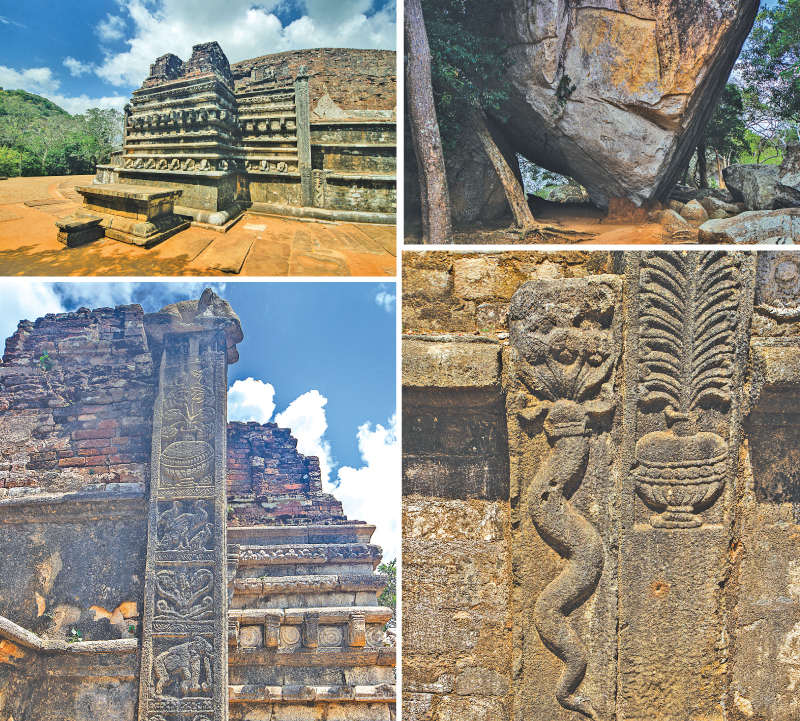 Mihintale is a once-in-a-lifetime experience for Buddhists. Many pilgrims take this as a wonderful opportunity to plan and visit with families. En route to Mihintale, there are many exciting features to experience and cherish.
Mihintale is a once-in-a-lifetime experience for Buddhists. Many pilgrims take this as a wonderful opportunity to plan and visit with families. En route to Mihintale, there are many exciting features to experience and cherish.
At the foot of the sacred Mihintale Mountain while the sun shines brightly, make-shift stalls offer ‘dodam’, a refreshing beverage to beat the heat. After a tiring journey, travellers can stop by for a cooling drink to revitalise themselves.
Preserve
It is more than just an ordinary spiritual journey, allowing one to immerse in the country’s extraordinary experiences while paying homage to the iconic landmark that has helped preserve the Dhamma. Mihintale is called the ‘Cradle of Buddhism’ in Sri Lanka.The ancient ruins in Mihintale with stone inscriptions speak volumes of historical significance.
Mihintale is also called the ‘rock of stupas’ as it is studded with numerous stupas, some renovated and immaculate, others left in original molds of brick. The Mihintale area is surrounded by dense jungle and rock boulders scattered around the mountainous region.
Upon reaching the foot of the mountain, one will be mesmerised by the views, and the ascent begins with the grand staircase, fringed by araliya trees. With the gentle breeze, the aroma of the flowers gently pervades the air accompanying a surreal feeling as the devotees begin their pilgrimage.
Although I have visited Mihintale on several occasions, I have never been to the Kantaka Chaitiya. I finally had a chance to make my own pilgrimage to the Kantaka Chaitiya with my family. En-route from Anuradhapura, one late morning last September, we climbed the stone staircase of Mihintale under the scorching sun to visit one of the most beautiful Chaitiya’s in Mihintale, the Kantaka Chaitya. Most visitors to Mihintale miss this place due to being unaware of its existence or unwilling to make the arduous trek to the site.
Once you climb half-way up the first long flight, you find a smaller set of steps under araliya trees taking the visitor to a plateau on the top of a hill. At this site, you can find cave abodes and the well-conserved Kantaka Chaitiya, 40 feet in height with a circumference of 425 feet at the base.
In the vicinity of the Chaitiya are numerous drip-ledged caves, which have been once a shelter for meditating bhikkhus who resided at Mihintale. The cave where Arahat Mahinda meditated, called the Mihidu Guhawa and other significant sites are spread throughout this mountain range.
This enormous brick-Chaitiya was built in the 2nd Century BCE. Even though it is one of the first dagabas to be erected in the country, history does not tell us when and who built the Kantaka Chaitiya. The Mahavamsa however, tells us that it was restored during the reign of King Lanjatissa (119-109 BCE).
Nothing was visible of this stupa until the commencement of excavations. Archaeological excavations at the Kantaka Chaitiya began in 1934 by eminent archaeologist and historian Prof. Senarath Paranavithana.
The ruined stupa mound was known Kiribandapavu dagaba, Kiribath Vehera or the Giribanda Seya by the locals. But a 1st century stone inscription found close by disclosed the original name as ‘Kataka Ceta’ of this stupa and later it was known as Kantaka Cetiya and finally as the Kantaka Chaitiya.
Vahalkadas
The Kantaka Chaitiya is famous for its four frontispieces, facing four directions which are a unique architectural feature called the vahalkadas base, with beautiful ornamental friezes of captivating dwarfs. Two of the four vahalkadas are preserved and in good condition. They are constructed with brick but the lower portion of the front sides are made of limestone.
The stone work of the eastern and the southern vahalkadas was found almost in a perfect state of preservation, while that of the northern one, though damaged, could easily be restored. The western vahalkada however, has been damaged beyond restoration.
The vahalkadas are profusely ornamented with sculptures. On the cornice below the topmost one is a frieze of ‘Ganas’ or dwarfs and on the one further below is a frieze of hamsa or geese. Many of the Ganas are portrayed in varies positions, some playing musical instruments, one playing with a Cobra, another standing on his head and so on. Some are animal headed.
The vahalkadas are flanked by stelae, the front and side of faces of which are sculptured with floral designs. The stelae were surmounted by figures of beasts, elephants at the eastern vahalkada and lions, horses and bulls at the northern, western and the southern ones. It is thought that these animals symbolise the four quarters. On the whole, these vahalkadas represent the oldest surviving finest Sinhala sculptures in the country.
From the site of the Kantaka Chaitiya when one looks to the West, one sees the captivating three great dagabas of Anuradhapura rising to the sky from the silvery waters of the great Anuradhapura tanks.










